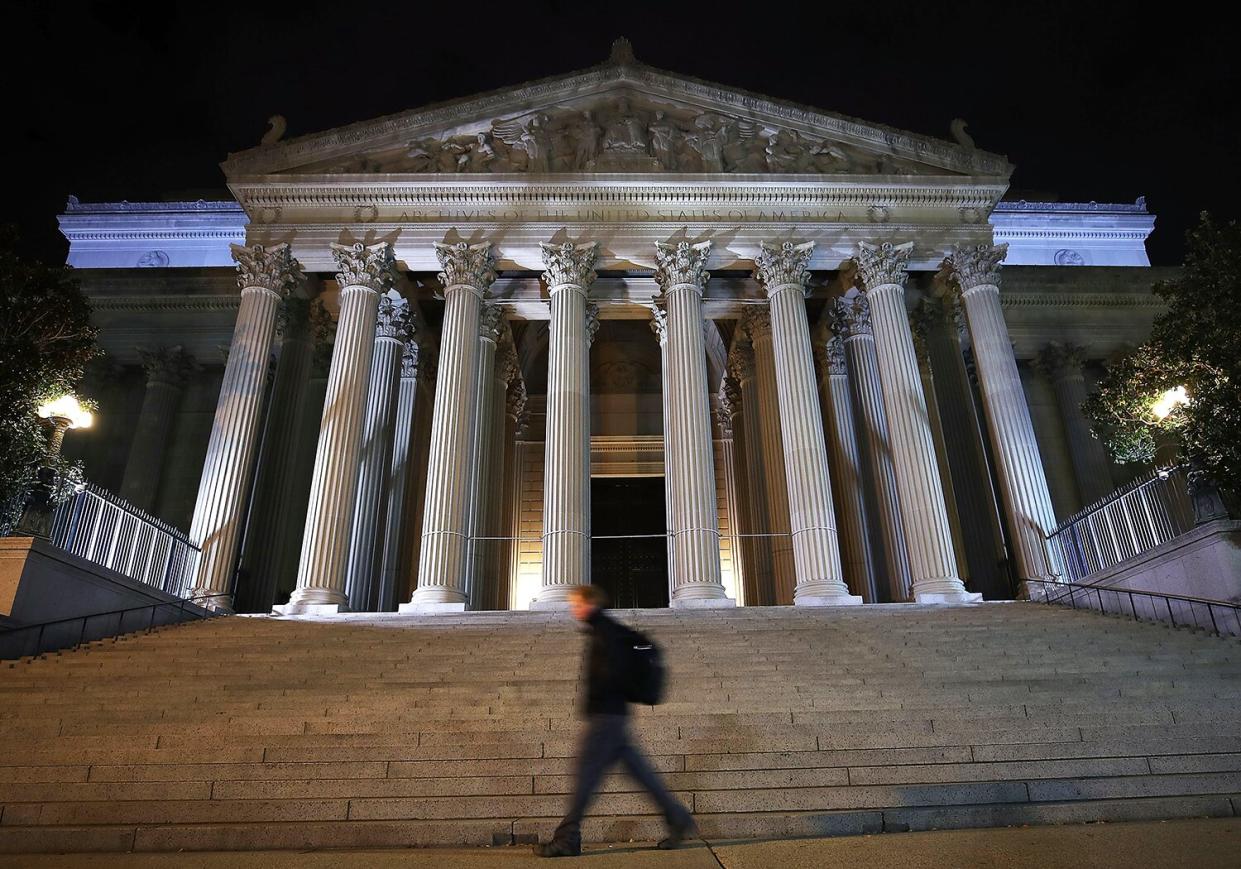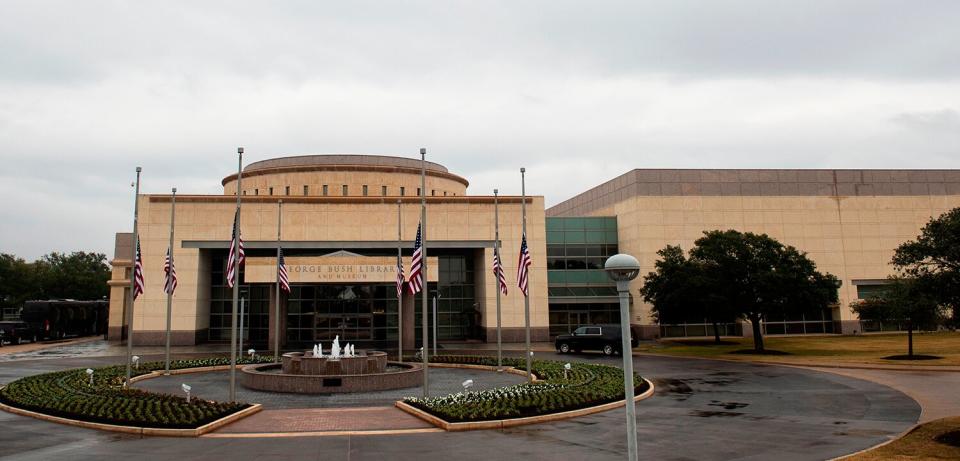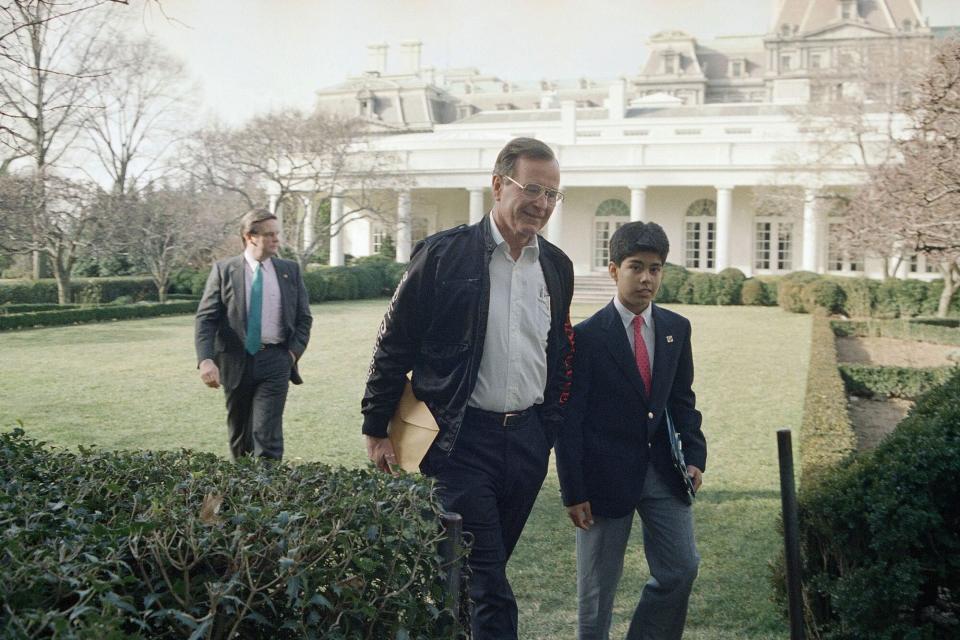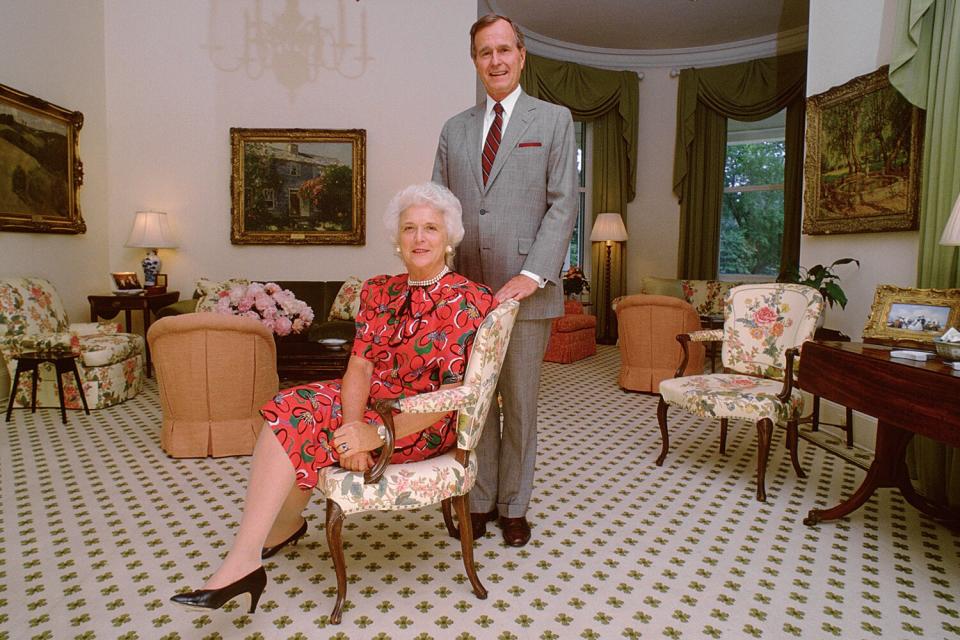A Sick Boy's Gift to Barbara Bush and a Wartime Letter to the Kids: Discoveries in a Presidential Archive

Mark Wilson/Getty National Archives building
White House administrations have a lot of secrets, a lot of responsibilities — and a lot of paper.
Nearly every piece of paper a U.S. president touches, in fact, is catalogued, first by the Office of Records Management and later by the National Archives, whose staffers pore over each document — from party invites to letters — before it can make its way into a presidential library.
Dr. Robert Holzweiss, deputy director of the George H. W. Bush Presidential Library and Museum at Texas A&M University in College Station, Texas, knows firsthand the diligent (and, often, monotonous) work required of categorizing presidential papers.
In 1996, Holzweiss was hired a junior archivist with the National Archives and joined the staff of the Bush library in 1996, when he began work sifting through papers that would eventually be on display and in the research room at the Texas facility.
"The work really begins once a president leaves office and continues until their library opens and even well after," he tells PEOPLE.
If it all sounds exceedingly particular, well, that's because it is. Sometimes maintaining American history starts one sheet at a time.
As Holzweiss explains, outgoing presidents get a five-year grace period to get all their documents organized before those records become subject to the Freedom of Information Act (meaning anyone, at that point, can file a FOIA request to access those documents). "So between 1993 — when [George] H. W. Bush left — and when the building opened, the staff readied the documents."
Speaking about his own experience cataloguing documents before the Bush library opened in 1998, he says, "The work was more routine than I expected. When you're going through millions of pages of documents, something things can be a little routine. But sometimes you find a diamond in the rough."
A few examples come to mind, Holzweiss says, like a homemade book a sick little boy sent to Barbara Bush or a letter her husband wrote to their kids ahead of war.
Of course, handling so much paper comes with rather pedestrian challenges, like: How do you avoid paper cuts? And how do you ensure historic documents don't get damaged?
"Before I was allowed to get into any documents — and this day-one kind of stuff — they sat us down and gave us an orientation into basic handling procedures," Holzweiss says.
Gloves come in handy to avoid pesky cuts but one of the best tools of the trade, he says, is a "staple remover that looks like a spatula. You had to be able to know how to use that because you don't want to rip the pages."
And there are lots of pages.
Holzweiss says that one "document" is actually a series of documents. A single invitation sent to the president for instance, might include the invite itself, along with routing instructions from the White House, drafts of the response, the actual response, copies and follow-up correspondence.
That many pages requires staples but metal actually degrades paper over time.

ANDREW CABALLERO-REYNOLDS/AFP/Getty George H.W. Bush Presidential Library and Museum
It was Holzweiss' job to remove the staples and replace them with acid free paper folded into tabs then placed under stainless steel paper clips (so metal wasn't touching the documents).
"Then you put it back in the box and describe what's in the documents, and create a narrative — so that when you're done, you can guide people through what these papers contain," he says.
The stacks of documents were then placed into folders and put on a shelf in a climate-controlled storage room.
"In all presidential libraries in the National Archives, the temperature and humidity of the room are absolutely of critical importance. And we're in Texas, so the humidity may get out of control sometimes. We have to adjust the HVAC system to ensure docs are well-stored and we use an electronic monitor to check the heat and humidity."
Once the documents are stored, archivists access the room as little as possible to keep the temperatures stable and ensure light doesn't degrade the paper. But before any of the documents even make their way to archivists, there is one looming obstacle: storage.
RELATED: Jill Biden Reflects on Barbara Bush and What It Means to Be First Lady: 'Nothing Can Prepare You'
Once documents are no longer "active" or in use, and a president is still in office, they will head to the Office of Records Management, which will gather data and write a brief description of the document, then place it in storage.
"It's in the basement of the White House, and they do an incredibly busy job, but there's not a lot of space," Holzweiss says. Once they run out of room in the basement, additional documents will go to the National Archives building on Pennsylvania Avenue, just down the street from the White House.
At the conclusion of a particular administration the balance of material is labeled and moved down to the National Archives, which conducts a final inventory before organizing the papers and putting them on a pallet, to be shipped by the military to a temporary facility near their final destination: a presidential museum.
Those facilities are located across the country, of course, and it's rare to find one that can store such a voluminous trove of paper. So archivists and museum staffers have to get creative.
"When I got involved the temporary facility for the Bush museum was in College Station, Texas, in an old bowling alley," Holzweiss says. "Without the alleys it was perfect, it was like a warehouse. They just built a secure space within to house the classified material."

Doug Mills/AP/REX/Shutterstock President George H. W. Bush (left) with grandson George P. Bush
RELATED: Mourners Line Up to See Barbara Bush Lie in Repose in Houston — Many Wearing Pearls in Her Honor
Temporary facilities for other presidential museums have been similarly creative. Ronald Reagan's documents, Holzweiss says, were housed in an old pasta factory before construction on his library in Simi Valley, California, was complete. "In that case, there was a special a consideration of whether the floor could support the weight of all those documents." (Thousands of reams of paper, it turns out, weigh a lot more than penne.)
Bill Clinton's files, meanwhile, found their temporary home in a former used car dealership, and Barack Obama'swent to a former furniture store.
Holzweiss is quick to note, however, that the most sensitive, highly-classified documents won't be included in those facilities and instead remained stored in Washington, D.C.
"There's information in some of those papers that is probably necessary to keep nearby where policymakers work. We get top-secret documents but they aren't nearly as sensitive as those most elite of documents. Frankly I'm glad — With great secrecy, comes great responsibility."
According to Holzweiss, some of the documents kept in the off-site facilities and, later, the museums themselves, are pretty standard.
"Someone would mail PEOPLE magazine into the White House with a letter that said, 'Mrs. Bush you were in PEOPLE Magazine,' " Holzweiss says of some of the documents he reviewed.
Other documents are more intriguing.
"When we were first cataloguing documents, a colleague found and handed to me a letter from Saddam Hussein congratulating Bush for winning the election in 1989," Holzweiss says. "We had actually gone through the Iraq material very early on in the process but this letter had been accidentally filed in King Hussein of Jordan's document trove."

David Hume Kennerly/Getty Images Barbara (sitting) and George H. W. Bush circa 1983
Another letter Holzweiss and team found was from a young boy battling cancer who wrote to then-First Lady Barbara Bush and enclosed a small book he had written called My Battle with Cancer.
"I picked it up and I couldn't put it down. He wanted to share his experience and tell her how brave he is, and how he's taking care of his mom and dad. I was absolutely blown away by the amount of effort he put into this project," Holzweiss says. "When you find that stuff, you have to pause and reassess your whole life."
He adds that many of the documents he's seen have helped to "humanize" world leaders most of the public doesn't see a personal side of.
"Around Christmas or New Years of 1990 — as it was becoming clear that Saddam Hussein would not leave Iraq — President Bush handwrote a letter to his kids about the burden he was bearing when it came to sending young men and women into harm's way. We have that letter on display in the museum and it's phenomenal," Holzweiss says.
While he says he's looked at many important and historic documents, papers like that are what stand out. "This was President Bush at his very, very finest. I've seen many fine documents but it's rare to get an inside look at a president talking to their own family."

